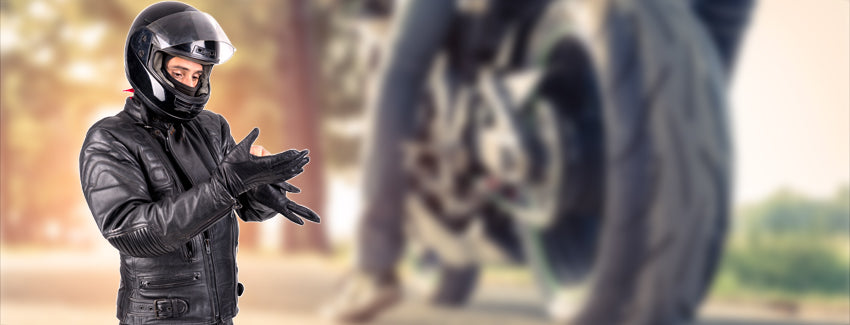| Riding and leathers are just meant to be together. But not all leather is created equal. Here is a detailed look at leather. | |
| Leather is measured in ounces. One ounce is 1/64 of an inch. So 7-8 ounce leather means it is 7/64s” to 8/64s” thick. | |
| Leather Types | |
| Leather is treated and cured animal hide. Most riders wear cowhide, but leather is made from many other skins. All About Leather has a detailed guide to the finished leather products. The description gives you a fairly good idea of what these various types are good for. | |
| Most riders wear “pigmented” leather, meaning it’s been colored and treated to resist wear. | |
| The most common leathers, in order of use are: | |
| Cow - Since this is the most commonly available, it’s also the cheapest. Various grades of leather produce different goods. Calfskin is used to make high-end soft gloves. Hides from mature animals make most of the leather used by bikers. | |
| Pig - Similar to cow, pig leather has a natural water resistance. It has lots of lanolin, a natural oil. | |
| Goat - Softer and tougher than cow hide, it also tends to be thinner. It’s used for high-end goods and leather wear that needs to be light. | |
| Sheep - This leather absorbs water more than others, making it not very good for outdoor wear. Most commonly found in high-end clothing and accessories. | |
| Deer - One of the toughest leathers around, it’s also expensive. The number of deer killed each year pales to the number of cows killed. Most of the deer hides are dumped with the bones and gut by hunters. It is good for riding leathers because of the abrasion resistance. | |
| Buffalo - The heaviest leather available. It’s used for everything that the above hides are used for as well as bookbinding, rugs and baseball gloves. Hair follicles cause a natural pebbly appearance. | |
| Ostrich - Often seen in expensive boots, this leather is also rare. It’s also used in high-end fashion accessories. | |
| Kangaroo - Light, strong and more durable than cowhide, kangaroo leather can be cut into layers. Bullwhips are a common use. Some soccer players prefer kangaroo leather shoes. | |
| Gator/Croc - This leather is made from the underside of the critter. The top part, with the heavy scales and ridges, can be turned to leather, but it’s not very wearable for everyday use. It’s most often used in luxury goods. | |
| Snake - Ultra-thin and not very strong or durable, snakeskins are exclusively used in high-end products and fashion accessories. | |
| Eel - Very thin like snake skin, but more durable. Eel skin is produced from the hagfish. | |
| Stingray - Very tough and durable. Stingray leather is also called shagreen leather. It can be used to protect things from fire. | |
| Leather Grades | |
| Leather comes in four grades. | |
| 1. | Full grain - This is the top layer of the skin. It has all the grain, our texture of the outer skin, hence the name full grain. It is also the most expensive. |
| 2. | Top grain - This is the second highest grade. It is taken from the top layer like full grain. But top grain is skin that has imperfections like blemishes, scars and scrapes. These can be sanded out or left alone. |
| 3. | Genuine leather - Grade 3 and made from the layers of hide that remain after peeling off the full and top grain. Can be smooth or rough. Suede is a common example. |
| 4. | Bonded leather - The leftover scraps are are glued and pressed together. This is the lowest quality leather. A major use is in book covers. |
| Caring for leather | |
| What you use leather for will dictate how you should care for it. Welding gloves are heavy, thick and cumbersome. They have to be to protect the welder from being burned. Rubbing down a set of welding gloves with oil is a bad, bad idea. Sparks could ignite the oil. | |
| Rubbing down a pair of riding boots with mink oil is a good idea. | |
| Here are a few tips for getting the most from your leather: | |
| If it gets wet, let it dry slowly. Putting heat on it changes the composition of the leather. | |
| If it gets too dry, rub an oil into it. LifeHacker says olive oil is a no-no. Don Gonzales Saddlery disagrees. “For oil, we use Olive Oil. We buy it from a local grocery supply company by the case and use it on both new and used leather items. I have heard of many people using canola, peanut, vegetable, and other food oils and they seem to work fine.” | |
| Both of them say putting oil or conditioners on dirty leather just works the stains deeper into the hide. Gonzales said Murphy’s Oil Soap works well as a cleaner. | |
| Don’t store it in plastic. Plastic seals the leather and will not allow moisture to escape. This can set up mold, mildew and other problems. | |
| Waterproofing | |
| Water and leather just do not mix. So how to you protect your riding gear from Mother Nature? The Art of Manliness has some suggestions on how to make your skins more water-resistant. Making your leather completely waterproof involves putting stuff into the leather, like boiling it in wax. This makes the leather heavier and extremely stiff. Think armor. | |
| Art of Manliness suggests commercial wax-based polishes that are rubbed on. This will make your leathers darker. It must be re-applied frequently. | |
| Some waterproofing compounds seal the water out, but they can make the leather stiffer or more slippery. Not something you want in gloves or gauntlets. It must be re-applied regularly. | |
| Waterproofing sprays have to re-applied frequently as well. Silicon-based sprays can also prematurely dry out your leather. | |
The Low-Down on Riding Leathers

Tags: Gear guides




